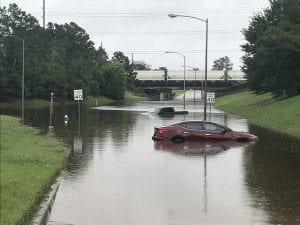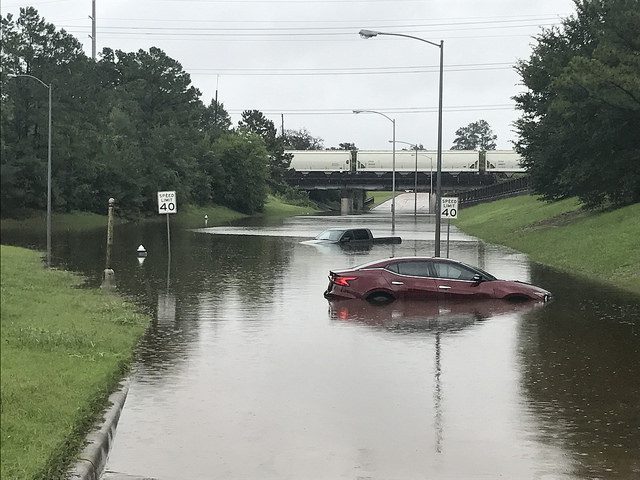
Hurricane Harvey. Credit: Michael Coppins via flickr, CC BY 2.0.
At Texas Housers, we’ve confronted a series of natural disasters over the past decade that forced us to develop new approaches for our housing advocacy. In the wake of Hurricane Harvey, we find ourselves back at it. Here are seven lessons we have learned.
- Strengthen your alliances with organized grassroots groups and leaders.
Post-disaster advocacy demands the rapid mobilization of a large number of people across multiple local jurisdictions to impact quickly-developing policy decisions. It’s a different process than the slower, more deliberative advocacy we engage in during non-disaster times. We depend on the knowledge and power of grassroots groups and leaders to assess situations on the ground and to amplify messages to public officials. These relationships, between advocates and community groups, are best built long before disaster strikes.
- Seek out and elevate the voices and experiences of marginalized survivors.
After a disaster, federal, state and local officials make hundreds of decisions about recovery—from the location of debris drop-off areas and food assistance application centers, to the allocation of billions of dollars for housing and infrastructure projects. Each of these decisions affects low-income communities of color to a disproportionate degree. The question is: Will impacted and marginalized survivors have a say in these decisions? Government officials do not often seek out voices of the marginalized. Advocates who seek equity and inclusion must ensure that elected officials hear the interests and voices of survivors loud and clear.
- Demand access to damage data immediately and use it; monitor programs and challenge programs that don’t deliver expeditiously and fairly.
FEMA damage assessment data shapes critical funding decisions. Advocates should demand access to this data and be prepared to supplement it with local knowledge about what is happening on the ground. Inevitably, initial and incomplete data will be relied on to make the most important decisions about what geographies get funds to rebuild, the division of funds between housing and infrastructure and the type of programs for assisting renters and homeowners. Demand this data. Analyze it. Use it to make the case to target people with low incomes and marginalized communities. Do not trust government agencies to be fair or do the right thing.
There will be a stampede of elected officials who will often be responsive to special and privileged interests. Many times, they allocate money with little oversight. As the recovery process spans months and years, keep an eye on programs and continue to demand data that will show how funds are being spent. This is public data about public funds—it belongs to the public. Insist on the fair share targeting of people of color and people with low incomes across all disaster recovery programs. Demand performance benchmark schedules. If agencies don’t assist all constituents equitably and in a timely manner, expose the problem and demand remediation.
- Focus on enforcement of civil rights laws.
When a community is devastated by disaster, long-unaddressed issues of unequal treatment of neighborhoods of color come to the surface. But community leaders and advocates are the ones who must frame the demands for equal treatment, not simply as political options for politicians, but as legal requirements. The reason disaster survivors are most often persons of color is because neighborhoods of color are almost always in the most environmentally vulnerable locations and often suffer from inadequate public infrastructure such as stormwater protection. Equitable recovery must overcome the historical discrimination that has produced unequal social vulnerability on the basis of race and ethnicity. The Fair Housing Act, Title VI of the Civil Rights Act of 1964, and other civil rights laws give advocates and communities leverage to force these inequalities to be addressed. Enlist a civil rights law firm or the lawyers at your local legal services organization to support these demands.
- Make your case everywhere, formally for the record and in front of the media.
There are moments when advocates and community leaders need to step up in disaster recovery. The development of the state CDBG-DR action plan is one of the most critical. Elected officials and government bureaucrats often try to short-circuit the public input process. Yet, it’s vitally important to assert the needs of low-income communities when public officials make decisions regarding the geographic and programmatic allocation of disaster recovery funds. They might actually listen. If they don’t, speaking out publicly at hearings strengthens your option to engage in appeals claims to FEMA, HUD and in the courts.
- Don’t permit disaster recovery to rebuild segregation and inequality.
Google “racial dot map” for your disaster impacted communities. More often than not what you will see is going to shock you. Extreme levels of residential racial segregation are the legacy of decades of governmental and private acts of discrimination. Don’t buy into just rebuilding what was there before the disaster struck. To do so would be to perpetuate the illegal and immoral practices of Jim Crow. Insist that disaster survivors are afforded the right to freely choose where to live. Insist survivors are provided real options. Demand that reconstructed government-subsidized apartments no longer are confined to high-poverty areas with low-performing schools. Insisting that Jim Crow is not the product of disaster recovery will be met by fear and opposition from some. But segregation must be acknowledged and overcome. Rebuilding homes and communities following a disaster affords a once in many generations opportunity for undoing centuries of residential discrimination.
- Be prepared to stay engaged for the long haul.
Unfortunately, rebuilding after disaster takes a long time. Our advocacy for equitable recovery following Hurricane Ike has taken more than eight years, and the State of Texas still hasn’t finished the job. But if you think about it, it’s well worth the effort. The amount of funds that have comes to the state of Texas for affordable housing and community infrastructure as a result of a series of disasters is far more than the amount of funds that would come to our state through the normal federal block grant process over a lifetime. This is a powerful way to make a difference in the lives of low-income families and in the conditions in low income communities.
Pray that you never have to confront the type of disasters that Texas, Florida, Puerto Rico, the Virgin Islands, and California have endured over the past months. But if you do find yourself in the situation, team up with survivors, be radical, and aggressively seize the opportunity.





Comments